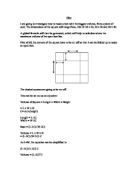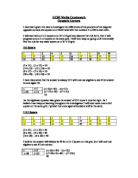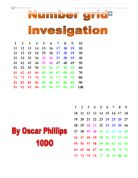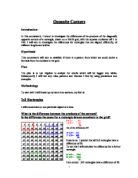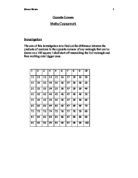Investigate the products of 2x2 number squares within a large 10x10 number grid.
Coursework Plan My coursework task is to investigate the products of 2x2 number squares within a large 10x10 number grid. My investigation will start by isolating a 2x2 square of numbers, I will then find the differences between the products of the top left & bottom right numbers, and the top right and bottom left numbers. I will then do this again with 3 more sets of numbers, and try to find a pattern. I will then go on to investigate 3x3, 4x4, 5x5, etc number squares within a 10x10 large number grid and see how the pattern, if there is one, changes and try and explain why it changes. After finding a suitable formula for number squares within a 10x10 large number grid, I will change the size of the large number grid to 9x9, 11x11, 20x20 etc, and repeat the process again, going through 2x2, 3x3, etc number squares, trying to find patterns. Once I have found a pattern for each of the large number grids, I will then try and work out a general formula for all number grids. Throughout my coursework I will be explaining all the things I am doing, and giving reasons for them. Year 10 Maths Coursework 2 3 4 5 6 7 8 9 0 1 2 3 4 5 6 7 8 9 20 21 22 23 24 25 26 27 28 28 30 31 32 33 34 35 36 37 38 39 40 41 42 43 44 45 46 47 48 49 50 51 52 53 54 55 56 57 58 59 60 61 62 63 64 65 66 67 68 69 70 71 72 73 74 75 76
In this investigation, I will attempt to find out some of the properties of a 2x2 square drawn within a 10x10 number grid. After this I hope to be able to investigate 9x9 and 8x8 grids, next I hope to move on to investigating rectangles.
MATHS Number Grid Coursework Introduction In this investigation, I will attempt to find out some of the properties of a 2x2 square drawn within a 10x10 number grid. After this I hope to be able to investigate 9x9 and 8x8 grids, next I hope to move on to investigating rectangles. 2 3 4 5 6 7 8 9 0 1 2 3 4 5 6 7 8 9 20 21 22 23 24 25 26 27 28 29 30 31 32 33 34 35 36 37 38 39 40 41 42 43 44 45 46 47 48 49 50 51 52 53 54 55 56 57 58 59 60 61 62 63 64 65 66 67 68 69 70 71 72 73 74 75 76 77 78 79 80 81 82 83 84 85 86 87 88 89 90 91 92 93 94 95 96 96 97 98 00 such as 35 36 45 46 when I find the product of the 2 sets of opposite corners I also find that the difference between these answers is ten: 2x2 squares square products difference 35 36 45 46 45 x 36 = 1620 35 x 46 = 1610 0 57 58 67 68 57 x 68 = 3876 67 x 58 = 3886 0 85 86 95 96 85 x 96 = 8160 95 x 86 = 8170 0 My findings are laid out here algebraically (s= starting number) 35 36 45 46 The +10 in the lower left corner is there because every row has ten numbers and so if you look down the columns you will see that here 35+10=40 and 36+10=46 and the +1 is there obviously because every number you count to the right is bigger by 1 i.e. 35+1=36 I shall use
The problem is to investigate the differences of corner numbers on a multiplication grid.
Number Grids The Problem The problem is to investigate the differences of corner numbers on a multiplication grid. Introduction To solve this problem I will have to choose several examples of squares on a grid: E.g. 2x2, 3x3, 4x4 To work this out I will need to take the opposite corners of the square and subtract them from the other sum of the two corners. This is easier seen in the diagram shown below: *The RED numbers are always multiplied then subtracted from the sum of the Blue numbers. 2 3 4 5 6 7 8 9 10 1 12 13 14 15 16 17 18 19 20 21 22 23 24 25 26 27 28 29 30 31 32 33 34 35 36 37 38 39 40 41 42 43 44 45 46 47 48 49 50 51 52 53 54 55 56 57 58 59 60 61 62 63 64 65 66 67 68 69 70 71 72 73 74 75 76 77 78 79 80 81 82 83 84 85 86 87 88 89 90 91 92 93 94 95 96 97 98 99 100 This is an example of a 2x2 square. I will then make an equation with this: Difference = (2x11)-(1x12) = 10 The difference for this example is ten. 2x2 Squares I will use on grid to use several example of 2x2 squares by placing them randomly on the grid. 2 3 4 5 6 7 8 9 10 1 12 13 14 15 16 17 18 19 20 21 22 23 24 25 26 27 28 29 30 31 32 33 34 35 36 37 38 39 40 41 42 43 44 45 46 47 48 49 50 51 52 53 54 55 56 57 58 59 60 61 62 63 64 65 66 67 68 69 70 71 72 73 74 75 76 77 78 79 80 81 82 83 84 85 86 87 88 89 90 91 92 93 94 95 96 97 98 99 100 From the squares I
Mathematics Borders
Level 8 I will now express the generalization formula in terms of sigma notation using square numbers. Below, I will show the sequence of cubes need to make a 3D cross shape through the help of level 7 in the form of a cross shape. This will be presented in a tabular manner Shape Number of cubes Sigma Notation 2 + 0 2 7 2 + 22 + 2 3 25 2 + 22 + 32 + 11 4 63 2 + 22 + 32 + 42 + 33 5 29 2 + 22 + 32 + 42 + 52 + 74 6 231 2 + 22 + 32 + 42 + 52 + 62 +140 6? = r2 r = 1 Since I have found the formula = Un = 4 n3 - 2n2 + 8 - 1 3 3 This will help me to find the number of cubes. Now I will find the formula for the square numbers of the sigma notation. Sigma Notation 2 2+22 2+22+32 2+22+32+42 2+22+32+42+52 2+22+32+42+52+62 Value 5 4 30 55 91 5 14 30 55 91 4 9 16 25 36 2nd difference --> 5 7 9 11 3rd difference --> 2 2 2 The 3rd difference is denoted by the term 6a. Therefore in order to find a, I will replace the 3rd difference value 6a = 2 a = 2 = 1 6 3 By the given formula, Un = an3 + bn2 +cn + d, I will now be able to arrive to the generalized formula. * If n=1 U1 = an3 + bn2 +cn + d = 1 (1)3 + b(1)2 + c(1) + d 3 = b + c + d = 2
Plan I am going to investigate how to make a box with the biggest volume, from a piece of card. The
Plan I am going to investigate how to make a box with the biggest volume, from a piece of card. The dimensions of the square will range from, 10x 10 20 x 20, 30 x 30 and 40 x 40. A global formula will then be generated, which will help to calculate where the maximum volume of the open box lies. First of all, the corners of the square have to be cut off so that it can be folded up to make an open box. The shaded squares are going to be cut off. This can be set out as an equation: Volume of Square = Length x Width x Height = L x W x H C= cuts (height) Length = L-2C Width = W-2C Base = (L-2C) (W-2C) Volume = L x W x H = (L-2C) (W-2C) C As L=W, the equation can be simplified to (L-2C) (L-2C) C Volume = (L-2C)2 C The first square measures 10 x 10. this is a preliminary set of results which I will obtain to determine the correct way to do the investigation. The volume and base area was then calculated. These findings are displayed in the table below. Length (cm) Width (cm) Height (cm) Base area Volume 8 8 64 64 7 7 2 49 98 6 6 3 36 08 5 5 4 25 00 4 4 5 6 80 3 3 6 9 54 2 2 7 4 28 8 8 0 0 9 0 0 In order to obtain a clearer view of how the volume changes with the size of the cut, I have plotted a graph. As the graph shows, the maximum value for volume lies between 3 and 4cm , where the graph is at its peak. I will
Maths Coursework: Number Stairs
Task Statement: I have been set the task of working out the relationship between a 3 - step stair total and the position of the stair shape on the prearranged grid and other stair totals. Aim: As I work through this task I hope to find a formula that will help me to work out any stair total on a 10 by 10 grid. Method: I began by calculating the stair in a vertical sequence ranging from 1 step stair to 8 step stairs. The results of these calculations highlighted a definite pattern. These results were then summarised in a table from which a general formula was found. Key: = Base Number n = Base number Step Stair: Difference = +1 +1 +1 +1 +1 +1 As we can see, the stair total for a 1-step stair using 1 as the base number on a 10 by 10-number grid is 1 as the total = 1. I can therefore conclude that the general equation for a 1-step stair on a 10 by 10 number grid is 1n + 0 = stair total where n is the base number. (Shaded box). Total of step containing 1 as its base number - Difference = 1- 1 = 0 (B) Base number Total number inside 2 2 3 3 4 4 5 5 6 6 7 7 8 8 Formulae: 1n + 0 = Total Testing the formula: Total = 1n + 0 Total = 1 * 2 + 0 Total = 2 + 0 Total = 2 2 Step Stairs: Difference = +3 +3 +3 +3 +3 +3 (B) Base number Total
Stair Investigation
Stair Investigation 45 35 36 25 26 27 This is a 3-step stair. The total of numbers inside the stair shape is: 25+26+27+35+36+45 = 194. The 3 stairs total for this step is 194. The smallest stair is in the bottom left corner of the grid: 21 1 12 2 3 The total of this grid is 1+2+3+11+12+21=50. The 3 stairs total for this stair is 50. Three step stairs can also be placed in other locations on the grid, in different places and positions. I will start in the bottom left corner, and move to the right by one square each time, because this is logical and methodical; the numbers will be sequenced. +2+3+11+12+21 = 50 2+3+4+12+12+22 = 56 3+4+5+13+14+23 = 62 4+5+6+14+15+24 = 66 5+6+7+15+16+25 = 72 6+7+8+16+17+26 = 78 this can be shown in a table: n Total 50 2 56 3 62 4 66 5 72 6 78 There is a trend in these results; every time the stair is moved to the right by one square, the total increases by six. Using this idea we can make a formula rule. If we use the bottom left corner as n, then n+1 is 50. The total increases by 6, so it is 6n. Therefore 6n+44 is the rule. This can be shown in previous results; 44+(6x1)=50, 44+(6x2)=56, 44+(6x3)=62, and so on. This is a consecutive stair. This formula can be checked by trying a different area of the grid, e.g. 25 to 28: 25+26+27+35+36+45 = 194 26+27+28+36+37+46 = 200 27+28+29+37+38+46 = 206 28+29+30+38+39+48
Number Stairs Coursework
Number Stairs Coursework Mathematics Number stairs coursework Aim: I have been given a 10 by 10 number grid (as shown below) with a stair shape drawn on it. The stair shape is a 3-step stair and the total of the numbers inside it is 194. 91 92 93 94 95 96 97 98 99 00 81 82 83 84 85 86 87 88 89 90 71 72 73 74 75 76 77 78 79 80 61 62 63 64 65 66 67 68 69 70 51 52 53 54 55 56 57 58 59 60 41 42 43 44 45 46 47 48 49 50 31 32 33 34 35 36 37 38 39 40 21 22 23 24 25 26 27 28 29 30 1 2 3 4 5 6 7 8 9 20 2 3 4 5 6 7 8 9 0 I am required to carry out the followings: * Part 1: To investigate the relationship between the stair total and the position of the stair shape on the grid for other 3-step stairs. * Part 2: To investigate further the relationship between the stair totals and other step stairs on other number grids. Plan for Part 1 I shall now investigate part 1 where I will show and explain the relationship between the stair total and the position of the stair shape on the grid for other 3- step stairs. The stair shape on the diagram is a 3 step stair because both the length and the width of the stair are 3 steps. Part 1 is basically all about drawing patterns and conclusions from the relationships, and constructing formulas based on them. To do this, I will change the
Investigating when pairs of diagonal corners are multiplied and subtracted from each other.
Investigating when pairs of diagonal corners are multiplied and subtracted from each other. Introduction: In this coursework I shall be investigating when pairs of diagonal corners are multiplied and subtracted from each other. To do this I shall take square grids and then select 3 square boxes from each grid and multiply the opposite corners then find the difference, then I will change the box size, to try and find a pattern or formula. Then I will change the grid size and then once again take boxes of different sizes and multiply the opposite corners and find the difference. I will try and find a formula for and square box on and size square grid. Then I shall investigate further by using rectangle boxes instead of square. 34 x 45 = 1530 35 x 44 = 1540 Difference = 10 68 x 79 = 5372 69 x 78 = 5382 Difference = 10 81 x 92 = 7452 82 x 91 = 7462 Difference = 10 In a 2 x 2 box on a 10 x 10 grid the difference is 10. Algebraic Method x x + 1 x + 10 x + 11 x(x + 11) = x² + 11x (x + 1)(x + 10) = x² + 10 + x +10x = x² + 11x + 10 x² + 11x - x² + 11x + 10 = 10 x 23 = 23 3 x 21 = 61 Difference = 40 36 x 58 = 2088 38 x 56 = 2128 Difference = 40 73 x 95 = 6935 75 x 93 = 6975 Difference = 40 In a 3 x 3 box on a 10 x 10 grid the difference is 40. Algebraic Method x x + 2 x + 20 x + 22 x(x + 22) = x² + 22x (x + 2)(x + 20) = x² + 20x + 2x + 40 =
I am going to investigate taking a square of numbers from a grid, multiplying the opposite corners and finding the difference of these two results
Maths Coursework Corners I am going to investigate taking a square of numbers from a grid, multiplying the opposite corners and finding the difference of these two results. To start I used a 5x5 grid: 2 3 4 5 6 7 8 9 0 1 2 3 4 5 6 7 8 9 20 21 22 23 24 25 Then I took 2x2 squares out of this grid and multiplied the opposite corners, to find the difference: 2 6 7 x 7 = 7 2 x 6 = 12 2 - 7 = 5 So the difference between the answers is 5. Next I took another 2x2 square from the same grid. 9 20 24 25 9 x 25 = 475 20 x 24 = 480 480 - 475 = 5 The difference is 5 again. I thought this could mean that all 2x2 squares in a 5x5 grid would come out with a difference of 5. To check this, I took another 2x2 square out of the grid to check. 2 3 7 8 2 x 18 = 216 3 x 17 = 221 221 - 216 = 5 So this shows that my prediction was right and every 2x2 square in a 5x5 grid should come out with a difference of 5. Any 2x2 square in a 5x5 grid = Difference of 5 Now I am going to start taking 2x2 squares out of a 6x6 grid. 2 3 4 5 6 7 8 9 0 1 2 3 4 5 6 7 8 9 20 21 22 23 24 25 26 27 28 29 30 31 32 33 34 35 36 2 7 8 x 8 = 8 2 x 7 = 14 4 - 8 = 6 The difference is 6. 21 22 27 28 21 x 28 = 588 22 x 27 = 594 594 - 588 = 6 Again the difference is 6. So I can see like in the 5x5 grid there is a pattern. If I am






